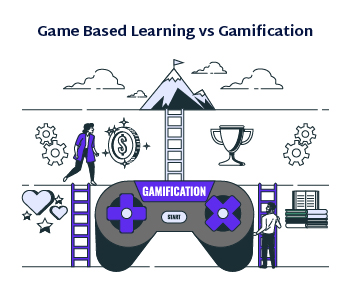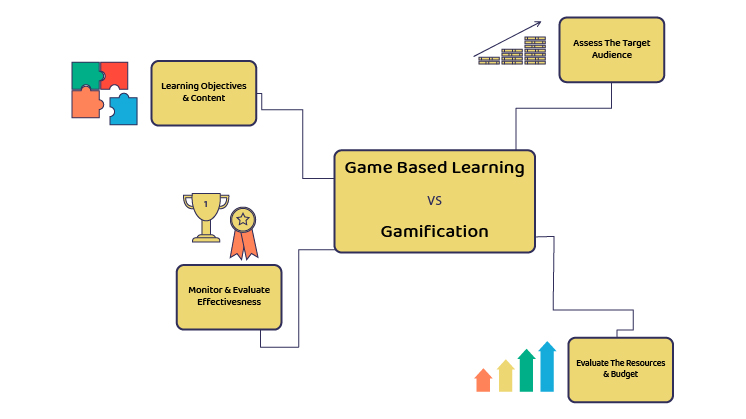In a world where attention spans are shrinking and distractions abound, trainers and educators across industries constantly look for new ways to engage learners and enhance their knowledge acquisition. Two approaches that have gained considerable attention in recent years are game-based learning and gamification. Both involve gaming factors but oppose design and objectives.
According to MarketsandMarkets, the gamification market is expected to grow from $9.1 billion in 2020 to $30.7 billion by 2025. Similarly, game-based learning will likely expand to $29.7 billion by 2026.
Generally, gamification involves incorporating game elements like points, badges, and leaderboards into a non-game context. That helps in enhancing motivation, engagement, and learning outcomes. In contrast, game-based learning involves using games themselves as a learning tool.
To know the differences between gamification vs. game-based learning, let’s analyze them through a wide lens.
What is Game-based Learning?
Game-based learning is a pedagogical approach involving physical or digital games to facilitate learning and cultivate learning outcomes. In this approach, games are designed to reinforce knowledge acquisition, problem-solving, critical thinking, and collaboration skills, among others.
“Did you know that game-based learning was introduced in universities as a pedagogical approach in the 20th century.
Although it emerged in the time of Generation X, it got immense popularity in recent years, mainly because of the easy accessibility of advanced technology. 70% of trainers mentioned that they notice an incredible boost in engagement when students are involved with educational video games.
The best example of this approach is Kahoot, a game-based learning platform that allows trainers to create interactive surveys, quizzes, and discussion-based activities. It has 30.9 million active accounts and is used by 70 million monthly active users across more than 200 countries.
Although game-based learning provides excellent exposure to trainees. Designing highly intellectual games requires time, resources, and proficiency. Some s can be suitable for learners. The most significant limitation is cultural appropriateness, facility to access, and unfriendliness with technology.
What is Gamification?
Just imagine you are in an office environment where everyone is eagerly working toward achieving their targets, and each one is vying to be at the top of the leaderboards. You must think this is a scene from a video game, but let the bubble burst. It is gamification.
If we go for a literal definition, it can be described as integrating game-like elements and mechanics in a non-game context. This will drive better user engagement and persuade them to accomplish specific goals and objectives. The rewards, challenges, and feedback mechanism make working on a task more enjoyable and meaningful, tapping into the innate inclination for play & competition.
One research reveals that the implementation of gamification in the workplace results in a staggering 48% surge in employee engagement levels.
Check out the complete history of gamification.
Countless brands are leveraging the power of gamification to create unprecedented brand loyalty, like Duolingo, a language learning app that uses gamification to make learning engaging and fun. It offers several language courses, each with levels and lessons that learners must complete to progress. Users earn points & virtual rewards for completing lessons successfully. It also allows you to compete with friends and other learners on leaderboards.
This approach is practical for engaging and motivating users. Despite its benefits, it has its fair share of challenges and constraints. Like over-reliance on games, elements can compromise the quality of learning and risk users becoming disengaged or addicted to the game mechanics.
| Factors | Gamification | Game-based Learning |
| Purpose | Meeting and engaging users | Tech or reinforce concepts |
| Core Mechanics | Points, badges, Leaderboards | Game mechanics (e.g, puzzles, quests, simulations) |
| Feedback | Immediate feedback for actions | Feedback integrated into gameplay |
| Learning Content | Non-game content with game-like elements | Learning content integrated into gameplay |
| Goal | Achieving specific objectives (sales/purchase target, completing tasks) | Learning specific skills and concepts |
| Interactivity | Typically less interactive than game-based learning | Highly interactive and immersive |
| User Engagement | Can increase user engagement and motivation | Known for boosting user engagement and motivation |
| Learning Outcomes | Enhance retention of information & improve performance on specific tasks | Improve understanding and application of concepts and skills |
It is not an exhaustive comparison of gamification and game-based learning
Comparison & Contrast of Game-Based Learning & Gamification
Now you know the typical definitions of game-based learning and gamification learning. Let’s dig together into game-based learning Vs. Gamification to understand the significant differences based on several factors:
1. Gamification vs. Game-based Learning: Similarities & Differences
– Similarities
- Including a game-like approach for creating interactive learning experiences.
- Increase user motivation and retention of information.
- Both can be tailored to meet specific learning objectives.
- Used in different settings, including education, corporate, marketing, and healthcare.
– Differences
- Game-based learning allows users to make decisions that impact the game’s result, while gamification is focused on achieving targeted goals and outcomes.
- Game-based learning often has a strong narrative that engages
- players and helps them learn, while gamification may not have a narrative element.
- Social learning is the main focus of game-based learning, but gamification mainly focuses on individual performance.
- Complexity is also pinpointed, which makes game-based learning different from gamification. The other one is simpler, with a focus on immediate rewards.
- Learning through a game-based approach provides a highly immersive experience, but gamification may be less immersive.
2. Advantages and Disadvantages of Game-based Learning & Gamification Learning
– Game-based Learning
| Advantages | Disadvantages |
| Allow players to experience diverse approaches | Expensive & time-consuming to develop |
| Often involves collaborative play | Require specialized hardware or software |
| Encourage exploration & discovery | Difficult for different learning outcomes |
– Gamification
| Advantages | Disadvantages |
| Encourage behavior change | Lead to short-term engagement |
| Foster a sense of achievement | It may not work in all context |
| Increase user retention | May distract from learning objectives |
3. Best Practices & Considerations in Choosing Between Game-based Learning and Gamification
When deciding between game-based learning and gamification learning, there are diverse practices and considerations to keep in mind.
- Considering learning objectives & content: Gamification is better for driving behavior or achieving goals, while game-based learning is best for teaching skills or concepts.
- Evaluate resources and budget: Game-based learning is expensive and time-consuming, while gamification is quick and affordable.
- Monitor and evaluate effectiveness: Measuring each approach’s learning outcomes and user engagement is necessary to determine the efficacy.
- Assess the target audience: only tech-savvy people can quickly improve their learning practice with game-based learning, but gamification is very user-friendly and can be used by everyone.
Wrap-Up
Game-based learning and gamification are two powerful approaches that can be used to enhance learner engagement and drive better learning outcomes. While each approach has its strengths and limitations, using the myCred plugin can take these strategies to the next level by creating a clear reward and recognition system that motivates learners to participate and achieve their goals.
By tapping into the innate human desire for achievement and recognition, the myCred plugin can transform the learning experience into an exciting and dynamic journey that keeps individuals for more. Whether you want to encourage desired actions or nurture defined abilities, combining gamification learning or game-based learning with the myCred plugin can help you empower your learners to succeed.


